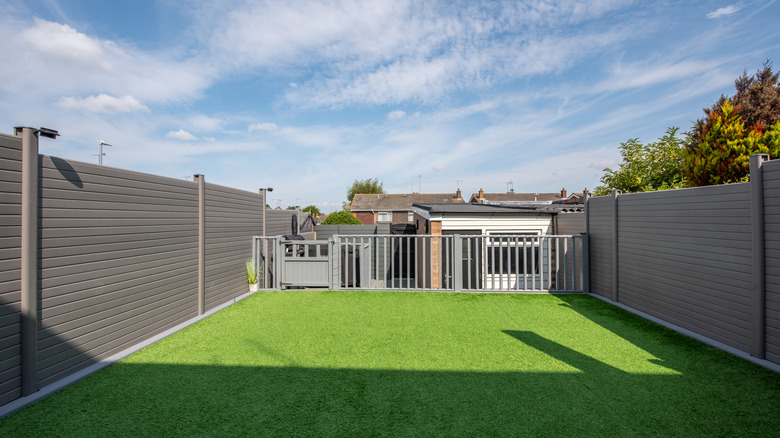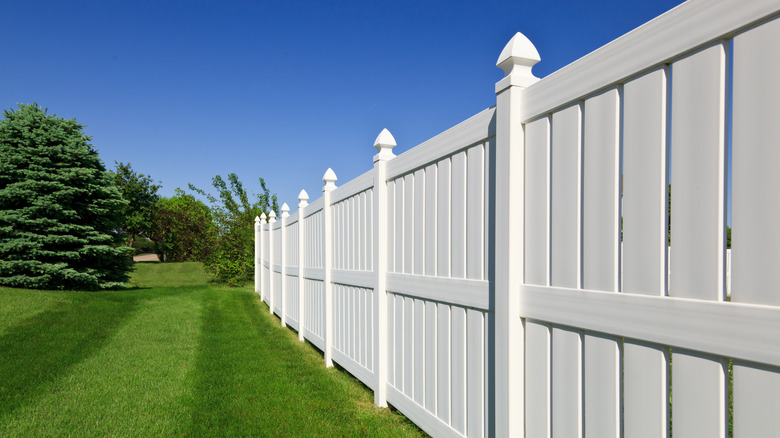Mike Holmes Shares The Two Wood Fencing Alternatives Worth The Extra Cost
Choosing the classic wooden fence may be the easiest decision to make for your property. They have dominated the fencing market for years because they are aesthetically pleasing, affordable, and easily customizable. This all seems great until you discover some of the unexpected downsides to a classic wood fence. Downsides that are so unavoidable, they led HGTV's Mike Holmes to offer up two alternatives to wood fencing: composite and vinyl.
Now, we know how much wood fencing installation costs, and that it's generally less than vinyl and composite. Mike Holmes knows that, too. However, the maintenance requirements for these wood fences can be quite demanding. These fences need regular painting and maintenance if you want them to last. And how long are we even talking about? The lifespan of a wooden fence is only about 10 to 20 years, which is nice, but pales in comparison with the aforementioned alternatives. Clearly, it's important to analyze all factors, including the outdoor environment and ongoing maintenance, before deciding on any material. This will help you avoid the mistakes everyone makes when installing a fence that can haunt you for years to come.
Composite fences might be better for you
Composite is one alternative to wood fencing that Mike Holmes recommends, and for many reasons. This material is made from a combination of recycled plastics and wood fiber, garnering some of the best benefits of both PVC and wood. You can expect a composite fence to cost about $11 to $45 per linear foot. This option costs more upfront than wooden fences, but when you consider other factors, you'll realize there's plenty of bang for your buck. Thanks to the plastic content, this material is more durable than wood, able to withstand the elements and anything else you (or the neighbor kid) might throw at it. They are highly water resistant which means, unlike wood, they won't rot or warp due to moisture exposure. Because of this, they last years longer than wooden fences, having an average lifespan of about three decades.
Wood is a popular option because many homeowners adore its appearance, but composite is also partly made of wood and is available in a variety of colors and finishes that imitate wood well. Basically, this option has all the beauty of wood with none of the high-maintenance baggage. They don't require sealing or treating, but simply an occasional cleaning with soap and water to look great. Finally, it's an eco-friendly choice: This material is made from recycled plastics that would otherwise have ended up polluting the environment.
Vinyl fences are also a great option
Also known as plastic or PVC fences, vinyl fences are made with polyvinyl chloride, and are Mike Holmes' second recommendation. To install a vinyl fence costs about $15 to $40 per linear foot. While these fences have a higher installation cost than wooden fences, they make up for that with more durability and a longer lifespan. Vinyl fences can hold their own against the elements better than wood. They aren't susceptible to water damage, and being synthetic, they won't be gnawed on by insects and rodents. Unlike wooden fences, these don't need much maintenance. Mike Holmes himself attests to that, pointing out that it doesn't ever need sealing, painting, or staining. These fences have an average lifespan of 20 to 30 years with none of the neediness of wood.
Many homeowners avoid vinyl fences for fear of the "cheap plastic" look, but modern PVC fences are much better quality than in the old days, and can mimic the look and feel of wooden. So you can rest assured your fence will look good. Finally, despite vinyl fences being made of plastic, there is still an eco-friendly element, as their longevity means less waste ending up in landfills (and many can be recycled). Plus, some manufacturers even use recycled plastic to make them, making the process even greener.


